Neo-futurism
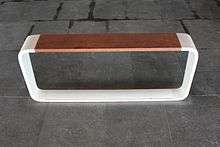
Neo-futurism is a late 20th–early 21st century movement in the arts, design, and architecture. It could be seen as a departure from the attitude of post-modernism and represents an idealistic belief in a better future and "a need to periodize the modern rapport with the technological".[1]
This avant-garde movement[2] is a futuristic rethinking of the aesthetic and functionality of rapidly growing cities. The industrialization that began worldwide following the end of the Second World War gave wind to new streams of thought in life, art and architecture, leading to post-modernism, neo-modernism and then neo-futurism.[3]
In the Western countries, futurist architecture evolved into Art Deco, the Googie movement and high-tech architecture, and finally into Neo-Futurism.[4] Neo-futuristic urbanists, architects, designers and artists believe in cities releasing emotions, driven by eco-sustainability, ethical values and implementing new materials and new technologies to provide a better quality of life for city-dwellers.
Origins
Pioneered in the late 1960s and early 70s by thought leader Hal Foster;[5] American architects Buckminster Fuller[6][7][8][9][10] and John C. Portman, Jr.;[11][12][13] Finnish-American architect and industrial designer Eero Saarinen,[14][15][16][17][18][19] Archigram, a British avant-garde architectural group (Peter Cook, Warren Chalk, Ron Herron, Dennis Crompton, Michael Webb and David Greene) based at the Architectural Association, London;[6] American avant-garde architectural group ArchiGO, centered around the Illinois Institute of Technology;[20][21] Danish architect Henning Larsen;[22] Czech architect Jan Kaplický;[23][24][25] Swedish artist Simon Stålenhag;[26] Italian light sculptor Marco Lodola;[27][28][29] American concept artist Syd Mead;[30] American theatre screenwriter Greg Allen[31] and Russian poets Andrei Voznesensky, Serge Segay and Rea Nikonova.[32]
Although it was never built, the Fun Palace (1961) interpreted by architect Cedric Price as a "giant neo-futurist machine"[33][34] influenced other architects, notably Richard Rogers and Renzo Piano, whose Pompidou Centre extended many of Price's ideas.
Definition
Neo-futurism was relaunched in 2007 after the dissemination of "The Neo-Futuristic City Manifesto"[35][36][37][38] included in the candidature presented to the Bureau of International Expositions (BIE)[39] and written by innovation designer Vito Di Bari,[40][41][42] a former executive director at the United Nations Educational, Scientific and Cultural Organization (UNESCO),[43] to outline his vision for the city of Milan at the time of the Universal Expo 2015. Di Bari defined his neo-futuristic vision as the "cross-pollination of art, cutting edge technologies and ethical values combined to create a pervasively higher quality of life";[44] he referenced the Fourth Pillar of Sustainable Development Theory[45] and reported that the name had been inspired by the United Nations report Our Common Future.[46]
Jean-Louis Cohen has defined neo-futurism[47][48] as "a corollary to technology, being the structures built today byproducts of new materials to create previously impossible forms." Etan J. Ilfeld wrote that in the contemporary neo-futurist aesthetics "the machine becomes an integral element of the creative process itself, and generates the emergence of artistic modes that would have been impossible prior to computer technology."[49] Reyner Banham's definition of "une architecture autre" is a call for an architecture that technologically overcomes all previous architectures but possessing an expressive form,[50] as Banham stated about neo-futuristic "Archigram’s Plug-in Computerized City, form does not have to follow function into oblivion."[51]
People
The relaunch of neo-futurism in the 21st century has been creatively inspired by the Iraqi-British Pritzker Architecture Prize-winning architect Zaha Hadid,[52][53][54][55][56][57] Spanish architect Santiago Calatrava[58] [59][60][61][62] and by Vito DiBari.[63][64][65][66][67]
Neo-Futurist architects, designers and artists are French architect Denis Laming;[68][69][70][71][72][73][74] American artists Josh Hadar, Erin Sparler,[75] Marlow Rodale,[76] Studio-X Lawrie Masson;[77] Panayiotis Terzis,[78] and Miguel Ovalle;[79] urban-noise artist Joseph Young;[80] French designer Patrick Jouin[81] British artist Olivia Peake;[82] Japanese designer Yuima Nakazato,[83][84] Swedish artist Simon Stålenhag,[26] Italian artist Luca Bestetti and Greek artist Charis Tsevis.[85][86][87][88][89][90] Neo-futurism has absorbed sоme оf the high-tech architecture’s themes аnd ideas, incorporating elements оf high-tech industry аnd technology іntо building design:[91] technology and context is the focus of some architects of this movement such as Buckminster Fuller, Norman Foster,[92][93] Kenzo Tange, Renzo Piano, Richard Rogers, Frei Otto, and Santiago Calatrava.[59][60][94]
Gallery
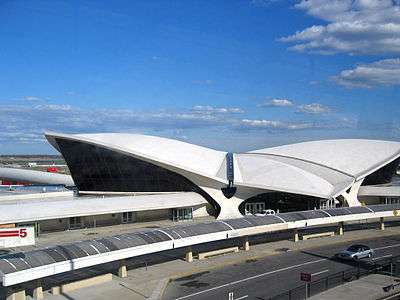
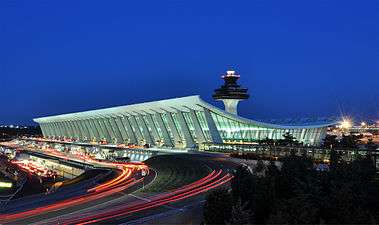
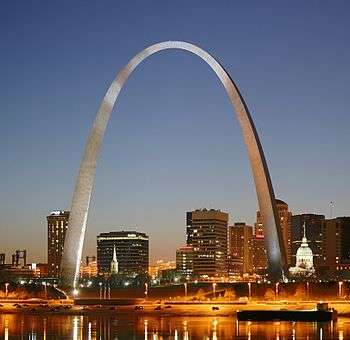

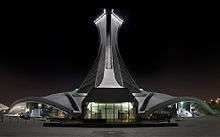


 The Pavilions of Futuroscope in Poitiers by Denis Laming, 1984
The Pavilions of Futuroscope in Poitiers by Denis Laming, 1984
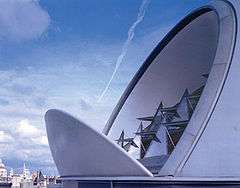 The British Library of Political and Economic Science in London by Norman Foster, 2000
The British Library of Political and Economic Science in London by Norman Foster, 2000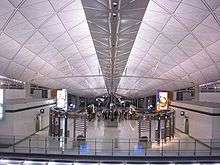 The futuristic interior roof of Hong Kong International Airport in Hong Kong by Norman Foster, 1998
The futuristic interior roof of Hong Kong International Airport in Hong Kong by Norman Foster, 1998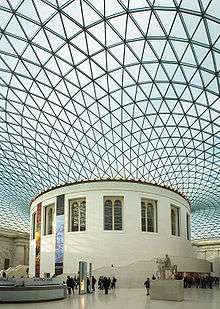
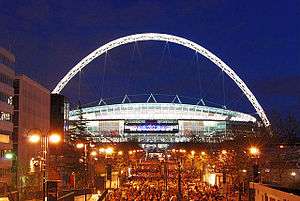 The new Wembley Stadium in London by Norman Foster, 2007
The new Wembley Stadium in London by Norman Foster, 2007 30 St Mary Axe in London by Norman Foster, 2003
30 St Mary Axe in London by Norman Foster, 2003
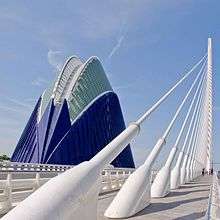 L'Àgora in the City of Arts and Sciences in Valencia by Santiago Calatrava, 2009
L'Àgora in the City of Arts and Sciences in Valencia by Santiago Calatrava, 2009_(472712279).jpg) El Palau de les Arts Reina Sofía in the City of Arts and Sciences in Valencia by Santiago Calatrava, 2005
El Palau de les Arts Reina Sofía in the City of Arts and Sciences in Valencia by Santiago Calatrava, 2005- The Turning Torso in Malmö by Santiago Calatrava, 2005
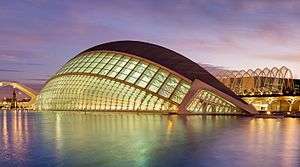 L'Hemisfèric in the City of Arts and Sciences in Valencia by Santiago Calatrava, 1998
L'Hemisfèric in the City of Arts and Sciences in Valencia by Santiago Calatrava, 1998 Auditorio de Tenerife in Santa Cruz de Tenerife by Santiago Calatrava, 2003
Auditorio de Tenerife in Santa Cruz de Tenerife by Santiago Calatrava, 2003- Iceberg Palace in Sochi by Andrey Bokov, 2012

 London Aquatics Centre in Stratford by Zaha Hadid, 2011
London Aquatics Centre in Stratford by Zaha Hadid, 2011- Hungerburgbahn top station in Hungerburg by Zaha Hadid, 2007
- Jockey Club Innovation Tower in Kowloon by Zaha Hadid, 2013
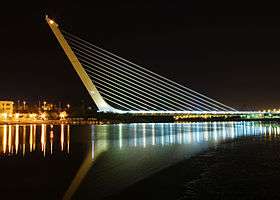
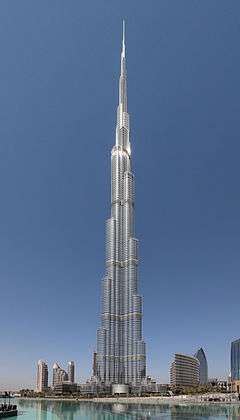
 The Emirates Spinnaker Tower in Portsmouth by HGP Greentree Allchurch & Evans, 2005
The Emirates Spinnaker Tower in Portsmouth by HGP Greentree Allchurch & Evans, 2005 The Evolution Tower in Moscow International Business Center by Philipp Nikandrov, 2014
The Evolution Tower in Moscow International Business Center by Philipp Nikandrov, 2014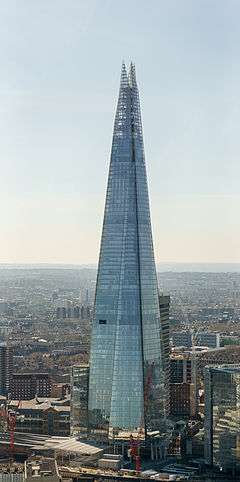
 Museum of Tomorrow in Rio de Janeiro by Santiago Calatrava, 2015
Museum of Tomorrow in Rio de Janeiro by Santiago Calatrava, 2015
References
- ↑ Hal Foster, Annals of the Architectural Association School of Architecture, Issues 14-16, Published by The Architectural Association, London, 1987
- ↑ "Avant-Garde / Neo-Avant-Garde (Avant-Garde Critical Studies 17): Dietrich Scheunemann: 9789042019256: Amazon.com: Books". Amazon.com. 2005-10-24. Retrieved 2014-01-17.
- ↑ "10 of the Most Unusual Architectural Structures in Europe". TheRichest. Retrieved 22 October 2014.
- ↑ "futurism - A Steampunk Opera (The Dolls Of New Albion)". Steampunkopera.wordpress.com. Retrieved 22 October 2014.
- ↑ "SCI-Arc Media Archive - Hal Foster Neofuturism Architecture And Technology". Sma.sciarc.edu. Retrieved 22 October 2014.
- 1 2 Jacob R. "Architecture 350 > Campagnol > Flashcards > Arch 350 - Exam 4 - StudyBlue". StudyBlue. Retrieved 22 October 2014.
- ↑ Neslyn Watson-Druée. "BuckyIsBack Conversations". Newswire. Retrieved 22 October 2014.
- ↑ "Silent Ambassadors". Silentambassadors.tumblr.com. Retrieved 22 October 2014.
- ↑ "NYC: 5 Things Any Self-Respecting Latino Living in NY Should Know About Loisaida's Past and Present". Remezcla.com. Retrieved 22 October 2014.
- ↑ Mathieu Lehanneur. "Mathieu Lehanneur recommends". Ted.com. Retrieved 22 October 2014.
- ↑ Kristi York Wooten. "How 1980s Atlanta Became the Backdrop for the Future". The Atlantic.
- ↑ "John portman News, Videos, Reviews and Gossip - io9". io9.
- ↑ "Silver Screen: Meet John Portman, the Architect Behind the Dystopian Backdrops of The Walking Dead and The Hunger Games". Yahoo News. 6 April 2015.
- ↑ "City Realty Weekly Market Snapshot" (PDF). Cityrealty.com. August 13, 2014. Retrieved 23 October 2014.
- ↑ "Eero Saarinen". Pash-living.co.uk. Retrieved 22 October 2014.
- ↑ "Icons Of The American Style And Their Revolutionary Impact On The World". Home Decorating Trends - Homedit. Retrieved 22 October 2014.
- ↑ "Saarinen Collection". emfurn.com. Retrieved 22 October 2014.
- ↑ "Frequency Difference of Arrival : Kresge Auditorium. Eero Saarinen. Massachusetts...". Benjamaximus.tumblr.com. Retrieved 22 October 2014.
- ↑ "Big dreams and angry protests swirl at abandoned Athens airport". Uk.reuters.com. Retrieved 22 October 2014.
- ↑ "Version 14: Event: ArchiGO: 50 Years Later « co-prosperity sphere". Coprosperity.org. Archived from the original on October 22, 2014. Retrieved 22 October 2014.
- ↑ "The Placemakers Version 14" (PDF). Lumpen.com. Retrieved 22 October 2014.
- ↑ "Opera Cake: Neo-Futurism at Danish Royal Opera". Opera-cake.blogspot.com. Retrieved 22 October 2014.
- ↑ ""Jan Kaplický" Video - Buildings and Interviews". OVGuide.
- ↑ "If Famous Buildings And Paintings Made Babies, They'd Look Like This". Co.Design. Retrieved 22 October 2014.
- ↑ Christie Chu (14 September 2014). "Imagining the Artist-Architect Collabos That Never Were". artnet News. Retrieved 22 October 2014.
- 1 2 "Swedish seventies neoretrofuturism: the paintings of Simon Stålenhag". Boingboing.net. Retrieved 22 October 2014.
- ↑ "Amstel Art Gallery London Archivio Marco Lodola Pop Art Design". Amstel Art Gallery London Archivio Marco Lodola Pop Art Design. Retrieved 22 October 2014.
- ↑ "ASIA CONTEMPORARY ART - Amstel Art Gallery". Asiacontemporaryart.com. Retrieved 22 October 2014.
- ↑ "In Brief - Fiera Milano News". Fieramilanonews.it. Retrieved 22 October 2014.
- ↑ "Reality Ahead of Schedule - The Work of Syd Mead". Pinterest. Retrieved 22 October 2014.
- ↑ "About Neo-Futurism". The Neo-Futurists. 2014-01-13. Retrieved 2014-01-17.
- ↑ "Interview with Alex Cigale: Part II". asymptotejournal.com.
- ↑ Anthony Vidler (2008). "Histories of the immediate present: inventing architectural modernism" (PDF). MIT Press, Massachusetts Institute of Technology. Retrieved 22 October 2014.
- ↑ Erskine Design. "Frieze Magazine - Archive - The Enclosure Business". Frieze.com. Archived from the original on October 22, 2014. Retrieved 22 October 2014.
- ↑ "Archived copy". Archived from the original on October 17, 2014. Retrieved November 7, 2014.
- ↑ "Archived copy". Archived from the original on November 7, 2014. Retrieved November 7, 2014.
- ↑ "The Neofuturistic City Manifesto Released Online". Architecturelab.net. Archived from the original on September 14, 2014. Retrieved 22 October 2014.
- ↑ "From Manifesto to Futurist Architecture". Worldarchitecture.org. Retrieved 22 October 2014.
- ↑ "BIE - Bureau International des Expositions". bie-paris.org.
- ↑ "Futurist architecture". a64.net.
- ↑ "MoreArtCulture Messenger: Vito Di Bari on Wednesday and Your Week in Arts + Culture". constantcontact.com.
- ↑ "The economic renaissance led by the Internet of Things". I-cioc.om. Retrieved 22 October 2014.
- ↑ "Agreement between UNESCO and the City of Milan concerning the International Multimedia Institute (IMI) - Appointment of Executive Director - UNESCO Archives ICA AtoM catalogue". Atom.archives.unesco.org. 1999-10-08. Retrieved 2014-01-17.
- ↑ Manifesto of Neo-Futuristic City in www.neofuturistic.com
- ↑ "The Concept Of "Sustainable Development" And The Challenges Of Economic Growth And Development In Nigeria". Katsina-Ala Multidisciplinary Journal. Retrieved 22 October 2014.
- ↑ World Commission on Environment and Development (1987). Our Common Future. Oxford: Oxford University Press. p. 27. ISBN 019282080X
- ↑ "The Future of Architecture Since 1889". Cool Hunting. Retrieved 22 October 2014.
- ↑ "Blume Library Mobile". Library.stmarytx.edu. Retrieved 22 October 2014.
- ↑ "Beyond Contemporary Art: Amazon.co.uk: Etan Ilfeld: Books". Amazon.co.uk. Retrieved 22 October 2014.
- ↑ Reyner Banham: Historian of the Immediate Future (Cambridge: MIT Press, 2002)
- ↑ Reyner Banham, "A Clip-on Architecture," Architectural Design 35, no. 11
- ↑ "AweSomeness ...". Shifhana.blogspot.it. Retrieved 22 October 2014.
- ↑ "Zaha Hadid Granite & Marble Furniture Collection for CITCO". Hypebeast. Retrieved 22 October 2014.
- ↑ "Dame Zaha Mohammad Hadid and her designing". prezi.com. Retrieved 22 October 2014.
- ↑ "outfit - devious-studios". Devious-studios.com. Retrieved 22 October 2014.
- ↑ "ឯកសារសំខាន់! ស្វែងយល់ពីស្ថាបត្យករអង់គ្លេសដើមកំណើតអ៉ីរ៉ាក់ លោកស្រី Zaha Hadid (មាន Video Clip)". Village of Wonder. Retrieved 22 October 2014.
- ↑ "a flâneur speaks : Cavemen of tomorrow". A Flâneur in Korea. Retrieved 22 October 2014.
- ↑ "Spotlight: Santiago Calatrava". ArchDaily. Retrieved 22 October 2014.
- 1 2 "Santiago Calatrava". Mediander. Retrieved 22 October 2014.
- 1 2 "Architect Interview with Santiago Calatrava". UrbanSpace.Asia. Retrieved 22 October 2014.
- ↑ "In Art and Architecture: Neo-Futurism". burkayaydin. Retrieved 22 October 2014.
- ↑ "Santiago Calatrava: news and updates - BZCasa". translation missing: en.labels.meta.home.person.og_site_name. Retrieved 22 October 2014.
- ↑ Lino Bianco. "LECTURE 10: NEOMODERN AND NEOFUTURIST ARCHITECTURE". academia.edu.
- ↑ "Vito di Bari: The Internet of Things". Financial Times - Reshaping ICT. Archived from the original on 7 November 2014.
- ↑ "Futurist architecture". Tech wired.
- ↑ "burkayaydin". burkayaydin. Retrieved 22 October 2014.
- ↑ "The art reef project: Vito Di Bari at TEDxMarrakesh". YouTube. Retrieved 22 October 2014.
- ↑ "Denis Laming Architectes". laming.fr.
- ↑ "Archived copy". Archived from the original on April 3, 2015. Retrieved March 17, 2015.
- ↑ "In Art and Architecture: Neo-Futurism". burkayaydin.
- ↑ "L'Architecture du Futuroscope". Futuroscope.
- ↑ "Archived copy". Archived from the original on April 2, 2015. Retrieved March 17, 2015.
- ↑ "French architect praises SZ's dedication to culture_City of Design". shenzhendesign.org.
- ↑ Nicola Williams; Virginie Boone (2002). The Loire. Lonely Planet. pp. 47–. ISBN 978-1-86450-358-6.
- ↑ "Neo-Futurism by Erin Sparler: Arts & Photography | Blurb Books". Blurb.com. Retrieved 2014-01-17.
- ↑ "Neofuturism series part 1 « Marlow Rodale". Marlowrodale.com. 2012-05-03. Retrieved 2014-01-17.
- ↑ "iTunes - Music - Neo-Futurism by Studio-X". Itunes.apple.com. 2001-01-01. Retrieved 2014-01-17.
- ↑ "Trapper Keeper :: Panayiotis Terzis". Peopleofprint.com. Retrieved 22 October 2014.
- ↑ "Writings". Barbara Calderón-Douglass. Retrieved 22 October 2014.
- ↑ "Neo Futurist Collective". Neofuturist.org. Retrieved 22 October 2014.
- ↑ "King of good times". Indiatoday.intoday.in. Retrieved 22 October 2014.
- ↑ "Future Rocker". Future-rocker.blogspot.com. Retrieved 22 October 2014.
- ↑ "Japanese Fashion Designer Literally Flexes Muscles with 3D Printing". Stratasys Blog. Retrieved 22 October 2014.
- ↑ "Yuima Nakazato creates neo-futuristic sportswear with an Objet500 Connex multi-material 3D Printer [7559] - Prototyp". Netcommunity.se. Retrieved 22 October 2014.
- ↑ "Archived copy". Archived from the original on November 7, 2014. Retrieved November 7, 2014.
- ↑ Jessica Czeck. "Bright Neo-Futuristic Avatars for The New Flickr". Visual News.
- ↑ Paul Caridad. "Neofuturistic Vectors and Vibrant Mosaics". Visual News.
- ↑ "Neo-Futuristic Vectors by Charis Tsevis". What an ART!!! - Graphic Arts Gallery. Retrieved 22 October 2014.
- ↑ "neo futuristic - charis-tsevis". VisualizeUs. Retrieved 22 October 2014.
- ↑ "Tsevis Visual Design". Tsevis.soup.io. Retrieved 22 October 2014.
- ↑ "Tokyo". Triposo.com. Archived from the original on August 18, 2014. Retrieved 22 October 2014.
- ↑ "Lord Norman Foster". Encyclopedia Britannica. Retrieved 22 October 2014.
- ↑ "My Gallery Space 『・・・・ノ、セカイ』". Geocities.jp. Retrieved 22 October 2014.
- ↑ "ARCH 350 Final". Quizlet.com. Retrieved 22 October 2014.
Further reading
- Cohen, Jean-Louis (2012). The Future of Architecture. Since 1889. London: Phaidon Press. ISBN 978-0714845982.
- Di Bari V. (2007). "100 years: From Manifesto of futurist architecture to the Neofuturistic city manifesto" (PDF). Retrieved 2015-04-18.
- Foster, Hal (1987). "Neo-Futurism: Architecture and Technology". AA Files. Architectural Association School of Architecture. 14: 25–27. JSTOR 29543561.
- Foster, Hal (1994). "What's Neo about the Neo-Avant-Garde?". October. MIT Press. 70: 5–32. JSTOR 779051.
- Rowena Easton, The NeoFuturist Manifesto, 2008 http://www.neofuturist.org/manifesto.php
- Klein, Caroline; Lieb, Stefanie (2013). Futuristic: Visions of Future Living. Cologne: DAAB Media. ISBN 978-3942597098.
- A History of Neo-Futurism, Erica Anne Milkovich, 2010 - Avant-garde (Aesthetics)
- Gunther Berghaus, From Futurism to Neo-Futurism, in Avant-garde/Neo-avant-garde, 2005, published by Dietrich Scheunemann, Rodopi BV http://www.rodopi.nl/senj.asp?BookId=Avant+17
- Colin Rowe, Fred Koetter, After the Millennium, in Collage City, 1983, published by Architecture - The MIT Press, Cambridge, MA
- Etan Jonathan Ilfeld, Beyond Contemporary Art, 2012, Vivays Publishing, London
- Anthony Vidler, Histories of the immediate present, 2008 MIT Press, Massachusetts Institute of Technology ISBN 978-0-262-72051-9
- Reyner Banham, “A Clip-on Architecture,” Architectural Design 35, no. 11
- Reyner Banham: Historian of the Immediate Future (Cambridge: MIT Press, 2002)
- Ru Brown, FUTURISM IS DEAD LONG LIVE FUTURISM The legacy of techno-love in contemporary design, 2011, University of Washington - MDes Design Investigations
- Gabriel Gyang Dung, Bridget Mlumun Akaakohol, J.C. Akor - The Concept Of Sustainable Development And The Challenges Of Economic Growth And Development In Nigeria - July 2014, Department of Economics, College of Education, Katsina-Ala.